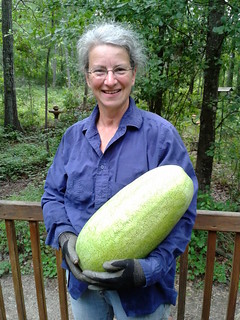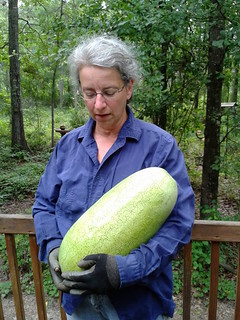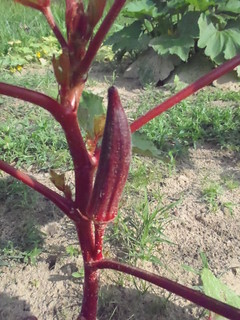Yes!
Video, Plenty more where that came from:
-jsq


Pictures and video by John S. Quarterman for Okra Paradise Farms, Lowndes County, Georgia, 3 July 2013.
Picked some more purple okra today, plus a beet, and plenty of green okra. Here are some of those compared with an orange okra. The purple okra on the left is the one from yesterday’s color wheel; it was picked smaller than these today, and looks almost black with some green. The ones today look more purple, somewhere between beet and fuschia; maybe red violet. The orange okra (same one from yesterday) looks red-orange or maroon with a bit of green. And the green okra looks, well, green.
Flash:
Continue readingMore orange okra coming along:


Pictures by Gretchen Quarterman for Okra Paradise Farms, Lowndes County, Georgia, 2013-06-27.
Soon we’ll compare to the purple okra.
-jsq
It turns out that okra pod from Monday was actually a stray green okra, not purple at all. But this, this is a purple okra. And another….
Three, Four, Five: Continue reading
Francine out for a walk between the creek and the house:
Species Profile: Florida Softshell (Apalone ferox) | SREL Herpetology
Like other softshells, the Florida softshell turtle (Apalone ferox) is a large, flat turtle with skin covering its shell (resembling a pancake). It is the bulkiest of the softshell turtles but inhabits the smallest range. It varies in size with males measuring from 6-12 inches (15-30 cm) and females measuring double that at 11-24 inches (28-61 cm). Adults are usually colored by a dark brown to brownish-gray with dark spots. Also there are usually small dark bumps on the carapace. In juveniles these dark bumps on the carapace are much more easily seen, as they are usually lighter in color than the adults. The carapace of the Florida softshell is covered with longitudinal rows of tubercles that resemble ridges in younger turtles but are less evident in larger turtles. In adult turtles the plastron of the shell usually extends farther than the carapace.Continue reading
If Monsanto’s crops are indistinguishable from non-GMO, aren’t natural crops prior art invalidating MON’s patents?
Ethan A. Huff wrote for NaturalNews.com 26 June 2013, Monsanto hypocrisy: GMOs supposedly identical to natural crops on safety, but unique for patent enforcement,
The biotechnology industry has pulled a fast one with regards to the legitimacy of genetically-modified organisms (GMOs). Straddling both sides of the fence, multinational corporations like Monsanto continually claim that their GM monstrosities are “substantially equivalent” to natural crops when it comes to their safety. And yet at the very same time, this ilk also insists that its products are uniquely different from natural crops when it comes to enforcing its patents, a clearly hypocritical and duplicitous stance that proves the illegitimacy of the entire GMO business model.
On its corporate website, Monsanto clearly expresses its opinion that Continue reading
Now easier to vote at the checkout counter (or the farmers market), at least for non-GMO meat.
Stephanie Strom wrote for NYTimes 20 June 2013, U.S. Approves a Label for Meat From Animals Fed a Diet Free of Gene-Modified Products,
The Agriculture Department has approved a label for meat and liquid egg products that includes a claim about the absence of genetically engineered products.
It is the first time that the department, which regulates meat and poultry processing, has approved a non-G.M.O. label claim, which attests that meat certified by the Non-GMO Project came from animals that never ate feed containing genetically engineered ingredients like corn, soy and alfalfa.
Seen here.
-jsq